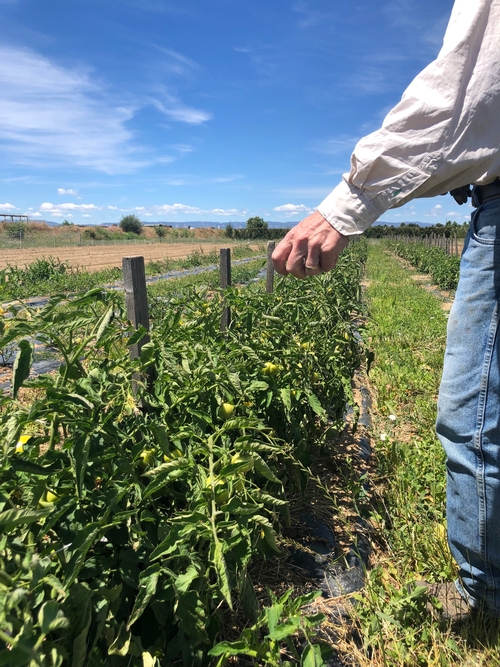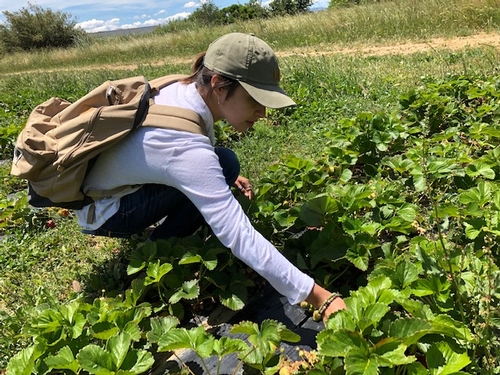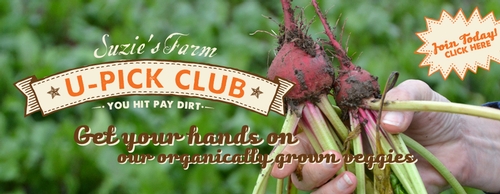
Posts Tagged: U-pick
Strawberry Fields Forever
As a Sustainable Agriculture and Food Systems student at UC Davis, I love having the opportunity to visit farms and ranches that are putting what I am learning in my classes into real practice. Pacific Star Gardens exceeded my expectations. Located near Woodland, CA Pacific Star Gardens is a diversified farm that offers a variety of fruits and vegetables for u-pick and also offers egg subscriptions for on-farm pick up by subscribers.
We were greeted by Robert Ramming at Pacific Star Gardens. He was more than happy to give a tour of the cultivated land. We toured the greenhouses where transplants are grown not only for Pacific Star Gardens but also for other farms and seed companies. Ramming also showed us a piece of land where he was growing Triticale and Rye as chicken scratch and feed. He explained how this is a financially better method than continuing to solely buy feed. Although he still purchases grain from feed stores to compensate for what he has not grown, his goal is to eventually switch to a full self sustaining method. We then passed by the tomatoes and apricots on our way to the berries which Ramming explained were the best crop to grow for a beginning u-pick farm.
Throughout our walk Ramming also shared some of his experiences being a small scale farmer. Pacific Star Gardens used to sell at local farmer's markets. Unfortunately, due to family changes, they had to stop farmers' market sales and subsequently withdrew from their organic certification because the cost was unaffordable without the farmers' market as a source of income. Despite not having organic certification, Pacific Star Gardens still maintains all organic practices to ensure the quality of product and trust of consumers. Pacific Star Gardens direct marketing sales currently include u-pick, some farm stand sales and egg subscriptions. Ramming mentioned that roughly 80 percent of sales are from people living close by and the other 20 percent of sales are from visitors coming in after seeing their Facebook page or through word of mouth.
This visit would have not been complete without a bag of strawberries to take home. Before leaving us, Ramming showed us to the farm stand where we grabbed a clean picking bucket and headed out to the strawberry field. I picked two pounds of yummy strawberries which cost $3.50 a pound. They accept either cash or PayPal/Venmo.
Blackberry u-pick will be coming up soon, so keep your eye out on Pacific Star Garden's Facebook page for more information to visit. https://www.facebook.com/pacificstargardens/
Customer Engagement: U-Pick Membership Programs
The people of Suzie's Farm, diversified organic growers in San Diego, have explored many ways to connect their customers to the farm and the good food growing on the farm. They offer regular farm tours, a CSA program, strawberry U-Pick days, farm dinners and other events. About a year ago, farm manager Lauren Gagliano Saline and her staff noticed that some of their customers wanted more chances to get their hands dirty, maybe to harvest their own CSA.
Suzie's staff tried an unguided vegetable U-Pick, letting customers pick vegetables from the fields. That didn't work out so well. Many people didn't know how to walk in the fields without trashing the beds, and didn't know how to harvest the different crops, and the random picking adventures tied up staff time. So Lauren and the team created a guided U-Pick option, and the U-Pick Harvest Club was born.
Now about fifty U-Pick Harvest Club members pick their own CSA every week. They join and prepay for four, eight, sixteen or more "picks". Each "pick" is a varying list of eight items with a set quantity of each item, designed to be approximately equal to a CSA share. Harvest Club members are told the times each week that they can pick their shares, on Tuesday, Saturday or Sunday. The picking times are when farm staff are leading their regular farm tours, so Harvest Club members join any of the tours and are supervised in their picking by the tour leaders. Of course they are not charged for the tour, which usually costs $10 per person.
Another advantage the U-Pick Harvest Club members enjoy is the chance to customize their pick, an option not available to regular CSA members. Rather than picking a set amount of each of the eight items, they are allowed to substitute more of one crop if they prefer. For example, they can pick eight melons one week if melons are one of the listed items, and take none of the other things on the list. And some people, Lauren explained, just prefer to pick that perfect bunch of kale. Harvest Club members are also allowed to bring along up to three people to "help" them pick - which includes the free farm tour.
The first year of Suzie's U-Pick Harvest Club has been a success, seeing steady growth and renewals for the second year. For more information, see Suzie's Farm website.

About four years ago, the Olsons set up a "U-pick/CSA Member Program," and now reserve the u-pick experience for farm CSA members. The price of membership is a case of Gabriel Farm's organic juice. For $36, customers get three gallons of juice and the ability to pick and purchase whatever is in season. Once they had the membership program established, Lucy and Torrey felt comfortable in opening up the U-Pick options to their full range of crops - from apples, pluots, berries, Asian Pears, tomatoes and flowers in August through persimmons and pineapple guavas in November.
Membership in the U-pick CSA program at Gabriel Farm averages about 500 families. A membership is good for a family or for a group of four people. Most customers are families with young children who want their children to learn where their food comes from and to be able to experience the farm. Most drive an hour or two from the greater San Francisco Bay Area. Lucy and Torrey are happy with their program. They have found that most people who make the membership commitment are supportive, kind and respectful of the farm.
Most U-Pick CSA members only come out to the farm once a year, as they are very busy people, Lucy explained, although she encourages all members to experience the apple harvest at least once if they start in a different season. Turnover in the program is about 80 percent, but enough new members join each year to maintain the average membership numbers.
The Olsons are not trying to grow their U-Pick program. They tried a hay pyramid one year for the children to play on, but decided that they didn't want to be in the agri-tainment business and did not repeat the experiment. They plan to continue to use the U-Pick membership program to limit the number of customers and to make more of a connection with people who enjoy and respect Gabriel Farm. For more information, see gabrielfarm.com/portal/u-pick
Twenty minutes of hail

Hail comes sometimes, suddenly and randomly, in February or March or April. It can hit one farm but not the one down the road. This time the sudden hail hit Woodland farmers Robert and Debbie Ramming, owners of 40-acre Pacific Star Gardens, on March 31, almost as if Mother Nature couldn't wait for April Fool's day.
Mid-April, in most years, is a good time to visit strawberry farms in the Sacramento Valley for the earliest fresh juicy berries, but 20 minutes of hail put off the start of U-pick strawberry season at Pacific Star Gardens until May. The plants will survive, but damage to the berries and other crops will mean a loss of $5,000 to $10,000 for the Rammings - a big hit for a small-scale farm.
The hail was huge, pea size to marble size, and it came in at a 45 degree angle, hurting Robert's head through his cap. It destroyed the field of strawberries just starting to turn pink and the newly planted cantaloupes and other melons that would have ripened in early July.

Pacific Star Gardens will recover. The next bloom of strawberries will be ripe and ready for U-pick in early May, with apricots and blackberries soon after. The farm is between Davis and Woodland, just off Highway 113. Check the Facebook page for what's ripe and when the farm is open for picking or purchase at the farm stand.
This is a farm story. This is a story of your food. It might make you think a little differently about strawberries, or about hail, or about the farmers at your farmers' market. Most farmers have stories to tell, and most would like the rest of us to understand a little bit about what it takes to grow crops and raise animals. We are lucky to have many opportunities to learn about and experience California farms and ranches.

UC is also partnering with the California Department of Food and Agriculture (CDFA) to help Californians explore California farms through a new page on the CDFA website, Discover California Farms. This one-stop portal to agricultural adventure helps visitors find a farm or ranch to visit, locate their closest farmers' market, find a community supported agriculture (CSA) farm that delivers weekly boxes of produce, learn about farm trails, fairs and festivals, or watch videos telling farmers' stories. California farmers and ranchers invite you to visit,taste, learn and enjoy!

U-Pick strawberry sign
The promise of peaches
Tomatoes grow fine in my Sacramento backyard. I can usually count on plenty of basil, more zucchini than the neighbors will take, some snow peas, chard and kale, a few small peppers and eggplants and whatever salad greens survive the slugs (in other words, lots of arugula). We have oranges and grapefruit, but I wouldn't even try to grow peaches or apricots. It takes a farmer to grow peaches. It takes a good farmer to grow good peaches. It takes a good farmer and good weather to grow Blenheim apricots.
Instead of planting a peach tree, I joined a fruit community supported agriculture (CSA) program, promising to pay $15 a week for a box of fresh fruit every week from June 7 until October 4. By joining I am agreeing to share the risk and the promise of the harvest of a four-acre fruit orchard with four part-time beginning farmers growing fruits and vegetables just west of Davis.
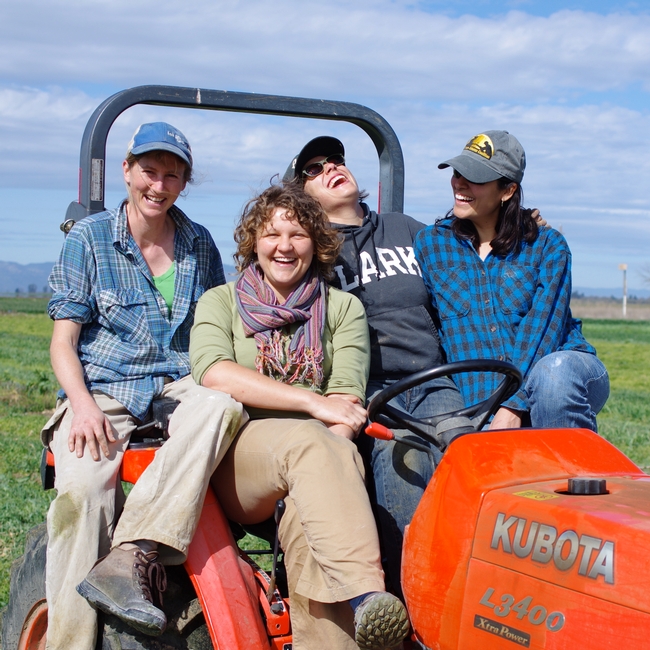
The Cloverleaf at Bridgeway Farms offers a chance that is, Aubrey White says, "both attractive and terrifying, with everyone trying to make it happen while keeping their jobs." The monetary investments were low, as they have no buildings or heavy equipment, and Collins offered a very attractive lease arrangement to encourage the new farmers. The vegetable land is certified organic and the orchard land is in transition to organic. The part that is terrifying is the risk of crop failure and poor yields that all farmers face.
The Cloverleaf farmers all have some farming experience, but the orchard presented new challenges. White started with the UC Master Gardener Program in Los Angeles, worked with urban farms and community gardens, and for two years at the UC Davis Student Farm. But, she says, taking on the orchard involved a "crazy different learning curve for three out of four of us." Even with all of her agricultural experience, she felt at a disadvantage not having a science background, particularly not having the soil science information to best manage the orchard.
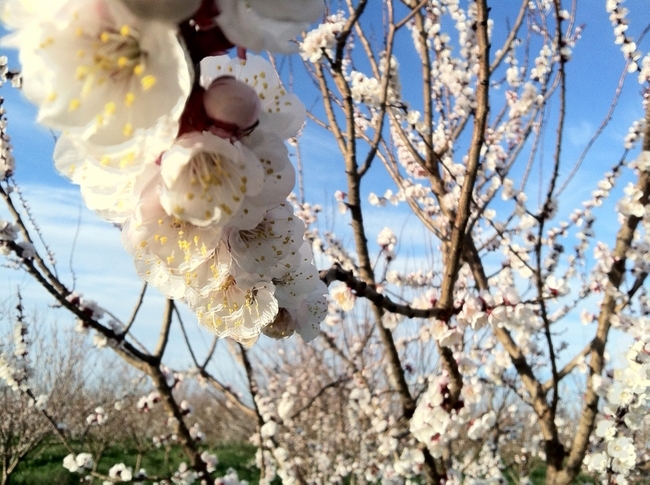
The original point of CSA programs was for the community (eaters) to share the risk of farming with the farmers, and to pay for a season's worth of produce up front to ease the cash-flow burden on the farmer before the harvest. In a pure traditional CSA, the farmer estimates the production for the year and sells shares in that production to as many families as the farm can be expected to feed. Each family receives a box of produce every week, with the full week's harvest divided up among the boxes. Some weeks there would be more variety than others; bounty and low yield would all be shared. Some years there would be good harvests and some years, poor harvests. The farmers are not at the mercy of the market, either wholesale buyers or competitive farmers' markets.
Most California CSA operators do not follow this traditional model, but sell to wholesale customers, restaurants, farmers markets and food processors in addition to the CSA customers. This means, in practice, that CSA customers do not share the full risk of the farm production and can expect a more consistent quantity in their box or basket each week. However, CSAs are an important and valuable part of most CSA operators' marketing plan. A UC study of several California organic farms selling through different marketing channels showed that the CSAs consistently returned the most profit to the marketing investment.
As a small farm with a young orchard, The Cloverleaf's fruit CSA still involves a little risk to the members. If the rain continues through June, as it did last year, we may not get those delicious Blenheims. Last year everyone lost them. But CSA manager White promises to give first priority to the CSA customers, with 25 to 50 percent of the fruit harvest going to CSA members. If needed, Cloverleaf will buy more blackberries from Collins or fill the boxes with the more successful varieties of peaches and nectarines.
In addition to the CSA, The Cloverleaf farmers will operate a farm stand, several U-pick days and a harvest festival this year, and sell fruit to several wholesale buyers. Just in case they don't have enough to do, they are considering introducing pastured chickens to the farm next year. The farm stand will open on Memorial Day at the Kidwell Road exit off Highway 80 between Davis and Dixon, and will remain open on Saturdays and Sundays until October. Information about the U-pick days and the harvest festival (and lots of other on-farm activities throughout California) will be listed on the UC Agritourism Directory, www.calagtour.org.
There might be a few shares left for the fruit CSA. For more information, visit the website or Facebook page of The Cloverleaf at Bridgeway Farms or email thecloverleaffarm@gmail.com. I'm looking forward to those peaches!
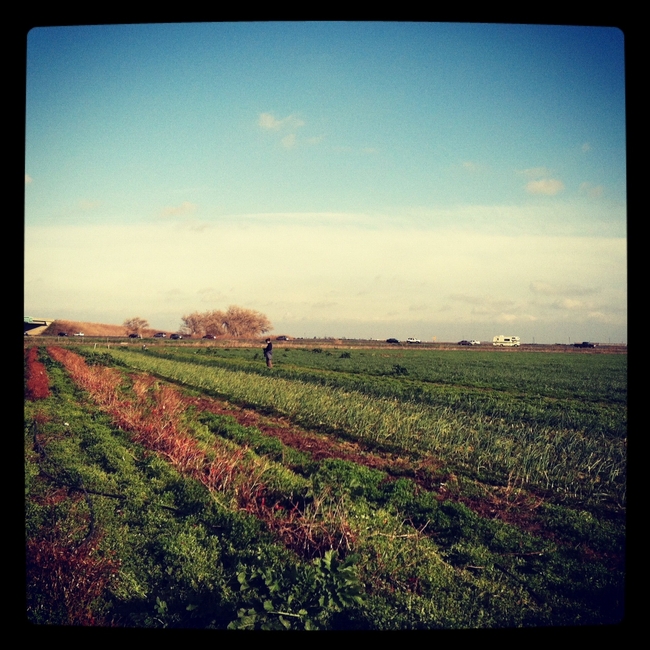
Fresh picked in the Delta

By 11 o'clock in the morning, Susila Prasab and her family had already picked about a hundred pounds of fresh crowder peas. They climbed off the tractor-pulled wagon that brought them back from the picking field with about five big mesh bags full, ready to get them weighed and pay the Kelley Farm 78 cents a pound. The fresh beans (crowder peas, like black eye peas, are really beans) would soon be shelled, cleaned, blanched and frozen, ready to use as the main ingredient for several months' Indian curry meals. Prasab told me the quick version of her curry recipe.
Quick Indian curry: Like many recipes, it starts with onion, garlic and chili sautéed in a pan with a little oil. Add curry powder and marsala. Wash the shelled fresh beans and add them to the pot. You can add potato or eggplant or tomato or cilantro, or all of them if you want. Add a little water, cook slowly, and serve with rice.
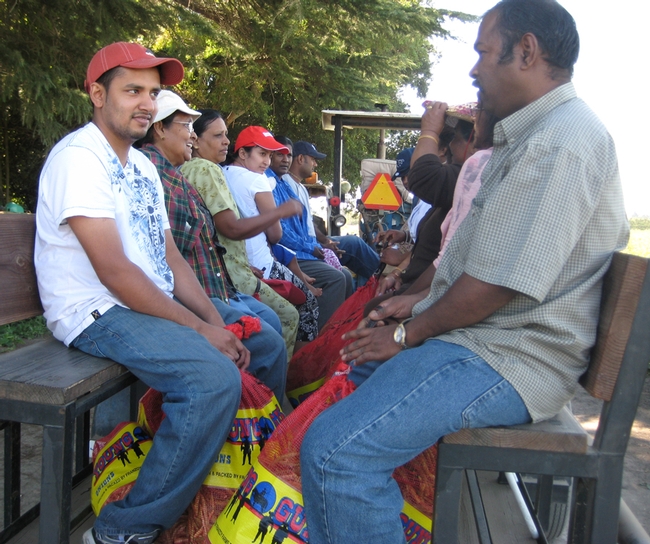
Nath Sam, from Fiji by way of Elk Grove, stopped picking purple beans for a few minutes to explain the best way to keep the beans for three seasons in the freezer:
Prepping fresh beans for the freezer: Shell the beans. Boil a lot of water. Throw the beans in for just a few seconds. Take them out quickly and cool them with ice. When they are room temperature, put them in a ziploc bag and seal it tightly. Put bags in the freezer.
R. Kelley Farms is open for picking or buying ready-picked fresh vegetables Wednesday through Sunday, July through October, from 8 a.m. to 6 p.m. On the day I visited, Lynette Hall, the Kelleys' daughter, was at the cash register. Hall told me she was surprised, at first, to learn that so many people all over the world have recipes for black eye peas, crowder peas, okra, and other ingredients for African-American soul-food specialties. Hall was more familiar with her mother's southern-style beans and offered her own recipes for stuffed zuchini or bell peppers and for Sucatosh.
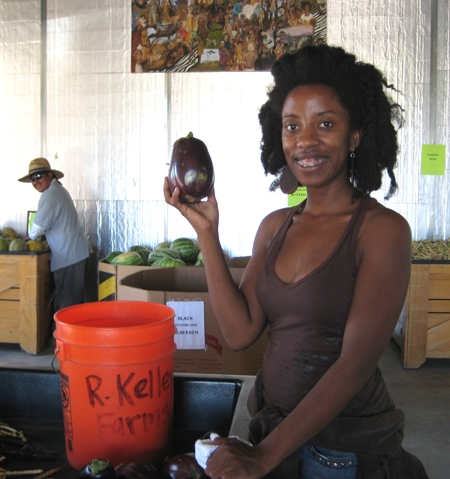
Lynette Hall's stuffed zucchini: Cut a big zucchini squash in half. Scrape out the seeds. Saute onions, garlic and bell peppers with some sausage and hamburger meat. Add some uncooked saffron yellow rice and a couple of eggs to bind everything together. Fill the hollowed-out squash halves with the mixture. Top with a layer of mozzarella cheese and some bread crumbs. Bake at 375 to 400 degrees for about 45 minutes.
Lynette Hall's succotash: Start with meat in a frying pan. When the meat is tender, add the vegetables, using any combination of onions, garlic, okra, peppers, squash, eggplant, tomatoes, fresh beans and corn. Cut the corn fresh off the cob, cutting the kernels half-way through. Then scrape the corn milk off the cob to get the juice. The corn juice adds to the tomato juice to flavor this dish. Season to taste. Serve over rice.
More black eye pea information and recipes.
When I paid for my beans at R. Kelley Farm, I picked up a flier on the counter telling me about fresh pears at Maggi's Farm, just next door. So of course I had to stop by Maggi's for some pears on my way home. But that's another story.


